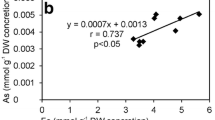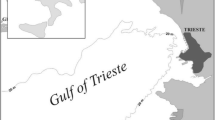Abstract
The Borra caves, Vishakapatnam, India, can be described as a speleothem cave with significant amounts of unexplored microbial mats in spring waters. Here, we present the first observations and hypotheses on the possible impact of the microorganisms in these mats on the cave formation, focusing on their role on iron mineral precipitation. The spring waters (pH neutral 7.5–7.7) contained dissolved metals like iron and the organic mat sludge (pH 7.0–7.3) had a TOC content of approximately 5.4 wt%. Geochemically, the spring waters deep below the microbial mats contained Fe 369 ppb, Sr 198 ppb; and the organic mat sludge contained Mg 9 ppm, Fe 427 ppb, Zn 149 ppb, Sr 190 ppb. XRD observations displayed Fe minerals (dominantly hematite), minor amounts of zinc gallium sulfide and nitrofuryl compounds. At least four groups of bacteria identified by direct microscopy and SEM-EDX on the basis of morphology could be observed in all samples: Leptothrix-like organisms, entombed bacterial mineral sheaths, a few stalks of Gallionella-like organisms and some additional bacteria that could not be further identified. Leptothrix-like organisms contained 43.22–60.08 wt % Fe and the mineral precipitated near and around these bacteria (in the actual unaltered samples on site) contained 30.76–45.22 wt% Fe as identified and quantified by SEM-EDX. This study indicates that the precipitation of these iron-rich mats in the spring waters could be linked to the presence of abundant active communities of iron precipitating bacteria at Borra caves, Vishakapatanam.




Similar content being viewed by others
References
Angert ER, Northup DE, Reysenbach AL, Peek AS, Goebel BM, Pace NR (1998) Molecular phylogenetic analysis of a bacterial community in Sulphur River, Parker Cave, Kentucky. Am Miner 83:1583–1592
Bas MJL, Subbarao KV, Walsh JN (2002) Metacarbonatite or marble?—the case of the carbonate, pyroxenite, calcite–apatite rock complex at Borra, Eastern Ghats, India. J Asian Earth Sci 20:127–140
Bhattacharya S, Kar K (2004) Alkaline intrusion in a granulite ensemble in the Eastern Ghats belt, India: Shear zone pathway and a pull-apart structure. Proc Indian Acad Sci (Earth Planet Sci) 113(1):37–48
Bhowmik SK, Dasgupta S, Hoernes S, Bhattacharya PK (1995) Extremely high-temperature calcareous granulites from the Eastern Ghats, India: evidence for isobaric cooling, fluid buffering, and terminal channelized fluid flow. Eur J Mineral 7:689–703
Egemeier S (1981) Cave development by thermal waters. Nat Speleol Soc Bull 43:31–51
Elia T Ben-Ari (2002) Microbiology and Geology: Solid Marriage Made on Earth. American Society for microbiology, ASM News, 68:1
Emerson D, Revsbech NP (1994) Investigation of an iron-oxidizing microbial mat community located near Aarhus, Denmark: field studies. Appl Environ Microbiol 60:4022–4031
Engel SE, Lee N, Porter ML, Stern AL, Bennett PC, Wagner M (2003) Filamentous Epsilonproteobacteria dominate microbial mats from sulfidic cave springs. Appl Environ Microbiol 69(9):5503
Engel AS, Porter ML, Stern LA, Quinlan S, Bennett PC (2004) Bacterial diversity and ecosystem function of filamentous microbial mats from aphotic (cave) sulfidic springs dominated by chemolithoautotrophic “Epsilonproteobacteria”. FEMS Microbiol Ecol 51:31–53
Fortin D, Langley S (2005) Formation and occurrence of biogenic iron-rich minerals. Earth Sci Rev 72(1–2):1–19
Fortin D, Ferris FG, Scott SD (1998) Formation of Fe-silicates and Fe-oxides on bacterial surfaces in samples collected near hydrothermal vents on the Southern Explorer Ridge in the northeast Pacific Ocean. Am Mineral 83:1399–1408
Hammes F, Verstraete W (2002) Key roles of pH and calcium metabolism in microbial carbonate precipitation. Rev Environ Sci Biotechnol 1:3–7
Hose LD, Palmer AN, Palmer MV, Northup DE, Boston PJ, DuChene HR (2000) Microbiology and geochemistry in a hydrogen-sulphide rich karst environment. Chem Geol 169:399–423
JCPDS–ICDD. XRPD database (2000) International Centre for Diffraction Data, 12 Campus Boulevard, Newtown Square, PA 19073–3273. Powder Diffraction File cards num, pp 5–586
Kinkle B, Kane TC (2000) Chemolithoautotrophic microorganisms and their potential role in subsurface environments. In: Wilkens H, Culver DC, Humphreys WF (eds) Ecosystems of the World 30. Elsevier, Amsterdam, pp 309–318
Konhauser KO (1998) Diversity of bacterial iron mineralization. Earth Sci Rev 43:91–121
Melim LA, Shinglman KM, Boston PJ, Northup DE, Spilde MN, Queen JM (2001) Geomicrobiol J 18:311–329
Mulder EG (1989) Genus Leptothrix Kuetzing 1843. In: Staley JT et al. (eds) Bergey’s manual of systematic bacteriology, vol 3. Baltimore, 1998–2003
Mulder EG, Deinema MH (1981) The sheathed bacteria. In: Starr MP, Stolp H, Truper HG, Balows A, Schlegel HG (eds) The prokaryotes: a handbook on habitats. Isolation, and identification of bacteria. Springer, Berlin, pp 425–440
Northup DE, Dahm CN, Melim LA, Spilde MN, Crossey LJ, Lavoie KH, Mallory LM, Boston PJ, Cunningham KI, Barns SM (2000) Evidence for geomicrobiological interactions in Guadalupe caves. J Cave Karst Stud 62(2):30–40
Pedersen K (2001) Exploration of deep intraterrestrial microbial life: current perspectives. FEMS Microbiol Lett 185:9–16
Poulson TL, Lavoie KH (2000) The trophic basis of subsurface ecosystems. In: Wilkens DC, Culver DC, Humphreys WF (eds) Ecosystems of the World 30. Elsevier, Amsterdam, pp 231–249
Sarbu SM, Kane TC, Kinkle BK (1996) A chemoautotrophically based cave ecosystem. Science 272:1953–1955
Schabereiter-Gurtner C, Saiz-Jimenez C, Piñar G, Lubitz W, Rölleke S (2003) Phylogenetic diversity of bacteria associated with Paleolithic paintings and surrounding rock walls in two Spanish caves (Lloný′n and La Garma). FEMS Microbiol Ecol 1606:1–13
Schieber J (2004) Ground water-fed iron rich microbial mats in a fresh water creek: growth cycles and fossilization potential of microbial features. Lunar Planet Sci 35:1369–1370
Simon KS, Benfield EF, Macko SA (2003) Food web structure and the role of epilthic biofilms in cave streams. Ecology 84:2395–2406
Singer PC, Stumm W (1970) Acidic mine drainage: the rate-determining step. Science 167:1121–1123
Stevens T (1997) Lithoautotrophy in the subsurface. FEMS Microbiol Rev 20:327–337
Vlasceanu L, Sarbu SM, Engel AS, Kinkle BK (2000) Acidic cave-wall biofilms located in the Frasassi Gorge, Italy. Geomicrobiol J 17:125–139
Acknowledgments
S. B. and R. B. thank the Wadia Institute of Himalayan Geology, Dehradun (WIHG), for laboratory and library facilities (ICP-MS, XRD, SEM-EDX). S. B. thanks the Council of Scientific and Industrial Research (CSIR), New Delhi (Research Associateship) for financial assistance in the successful completion of the project. R. B. thanks the World Bank for financial assistance to attend the FISH training programme in connection with this project at Technical University, Munich, Germany.
Author information
Authors and Affiliations
Corresponding author
Rights and permissions
About this article
Cite this article
Baskar, S., Baskar, R., Lee, N. et al. Precipitation of iron in microbial mats of the spring waters of Borra Caves, Vishakapatnam, India: some geomicrobiological aspects. Environ Geol 56, 237–243 (2008). https://doi.org/10.1007/s00254-007-1159-y
Received:
Accepted:
Published:
Issue Date:
DOI: https://doi.org/10.1007/s00254-007-1159-y




